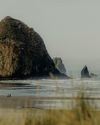
THE MORNING SUN was already high and hot, penetrating a blue sea haze that softened the forested islands on the horizon. The silhouette of a cargo ship inched north along the diffuse line between sky and sea, toward the frenetic cities on the mainland of Honshu. But where I was, all was peaceful.
In the milky blue below my Prestige stateroom balcony, two large Chrysaora jellyfish pulsed nonchalantly along the hull of Ponant's 466-foot Le Soléal. Just the night before, this luxury expedition ship had transported me from the bustle of Osaka's crowds and heavy industry to the mysterious and beautiful Seto Inland Sea, the body of water that separates Japan's main islands: Honshu, Shikoku, and Kyushu.
The Seto Inland Sea was Japan's most important trade route for centuries, before road and rail. Its port towns prospered, hosting seafarers as they waited for tides to propel them east toward the imperial capitals or west toward the Sea of Japan, which was the way I was headed on this eight-day cruise from Osaka to Fukuoka. Traveling by sea remains the best-though least utilized-way to explore this sleepy region, which most travelers bypass at 185 miles an hour aboard the Tokaido-Sanyo shinkansen.
Le Soléal, which turned 10 last year, is a sleek, small ship with cutting-edge tech to reduce its impact on the environment. On my first morning, I descended to the marina deck to board one of her 12 Zodiacs (Ponant is the first international company permitted to operate Zodiacs in these waters), bound for Inujima ("dog island"), our first port of call. Inujima is the smallest of the four islands that comprise Benesse Art Site Naoshima, a revolutionary art project that started on Naoshima in 1992 and expanded onto its neighbors. Its innovative proposition to use art to drive rural regeneration has put the Seto Inland Sea firmly on the global art map.
Diese Geschichte stammt aus der January - February 2024-Ausgabe von Condé Nast Traveler US.
Starten Sie Ihre 7-tägige kostenlose Testversion von Magzter GOLD, um auf Tausende kuratierte Premium-Storys sowie über 8.000 Zeitschriften und Zeitungen zuzugreifen.
Bereits Abonnent ? Anmelden
Diese Geschichte stammt aus der January - February 2024-Ausgabe von Condé Nast Traveler US.
Starten Sie Ihre 7-tägige kostenlose Testversion von Magzter GOLD, um auf Tausende kuratierte Premium-Storys sowie über 8.000 Zeitschriften und Zeitungen zuzugreifen.
Bereits Abonnent? Anmelden

HERE COMES THE SUN
Aussie designers Nicky and Simone Zimmermann share their favorite spots in Sydney

why we travel
EXPERIENCES THAT CHANGE THE WAY WE SEE THE WORLD

Safari at Sea
On the first sailing of ecotourism brand andBeyond's new cruise in the Galápagos, Chris Schalkx learns a lesson in conservancy

A Quiet Place
While trekking through a remote sweep of the Serengeti, Rebecca Misner learns how to live in the moment

In Tune
Jamming with nomadic Nepali performers, Justin Goldman discovers the common ancestry of folk music around the globe

Word of mouth
Osaka, the wilder cousin of hip Tokyo and precious Kyoto, is getting a well-timed tune-up

Roots Revival
In Tuscon, Betsy Andrews finds a community preserving its culinary future through ancient ways

LOVE ETERNAL
The magic of Italy creates the setting for designer Athena Calderone to celebrate two major life moments

go with the flow
On the central Oregon Coast, Alice Gregory finds easygoing small towns, forest-framed beaches, and an unhurried way of life refreshingly far removed from the world of hipsters and influencers

good vibrations
Explore the season's best beach-ready looks in their element: Costa Rica's breezy Pacific shores